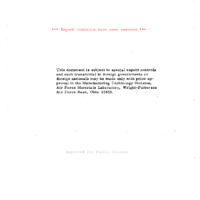-
Title
-
Chemical Vapor Deposition (CVD) Barrel Coating for Refractory Fasteners
-
Date
-
1969
-
Index Abstract
-
Not Available
-
Photo Quality
-
Complete
-
Report Number
-
AFML TR 69-316
-
Creator
-
Wakefield, Gene F.
-
Yaws, Carl L.
-
Corporate Author
-
Texas Instruments, Incorporated
-
Laboratory
-
Air Force Materials Laboratory
-
Extent
-
266
-
Identifier
-
AD0865504
-
Access Rights
-
Export Controls
-
Distribution Classification
-
1
-
Contract
-
F33615-68-C-1433
-
DoD Project
-
474-8
-
DoD Task
-
None Given
-
DTIC Record Exists
-
No
-
Distribution Change Authority Correspondence
-
USAFSC LTR
-
Distribution Conflict
-
No
-
Abstract
-
Potential manufacturing-production equipment was established via CVD-barrel coating technology in this program for applying CVD coatings to large quantities of spall parts (i.e. refractory fasteners for aerospace structures). In Phase I, the practical equipment was designed, constructed, installed and tested in start-up. In these initial runs, trideposition reaction of hydrogen reduction of gas phase silicon, titanium and chromium chlorides was demonstrated as a CVD chemistry base for depositing chromium-titanium-silicon (Cr-Ti-Si) coating on small parts. In Phase II, optimization, production and evaluation studies were conducted with the designed equipment. Coating improvements including apparent optimum region and key process parameter effects were achieved with statistical runs and analyses (i.e., T- and F-tests at 95% confidence level). Process development was scaled-up to large quantities by uniform coating many small parts: (a) 1/4-in. dia. Round rods, 3 per run; (b) 1-in. threaded studs, 6-10 per run; ? 1 1/2-in. hex head bolts, 10 per run; (d) mixed shapes-bolts, studs, rods and flat panels, 20 per run; (e) refractory fasteners-bolts, studs and nuts, 30 per run; and (f) production demonstration-refractory fastener bolts and nuts, 30-50 per run. More than twenty demonstration runs at the incresed capability (i.e. coating 30-50 substrates per run) were conducted with reproducibility to illustrate that the CVD-barrel coating technology is within potential manufacturing production scope. Important coating properties (i.e. oxidation resistance for substrate protection, Cr-Ti-Si concentrations, mechanical strengths, etc.) were evaluated. For 2400 F oxidation environment, more than eighty and twenty hours of protection was achieved for round rod and refractory fastener small parts from production demonstration batches. Uncoated parts experienced severe failure in less than one-half hour. Cursory literature screening revealed favorable state-of-art comparison based on this program and two independent literature sources. In Phase III, gluoride and chloride routes were investigated for tungsten-tungsten silicide (W-WSi2) coating of tantalum. For the fluoride route, tungsten coating of tantalum T222 was demonstrated with uniform coverage of round rod small parts.
-
Report Availability
-
Full text available
-
Date Issued
-
1969-12
-
Provenance
-
Lockheed Martin Missiles & Fire Control
-
Type
-
report
-
Format
-
1 online resource
 AFMLTR69-316.pdf
AFMLTR69-316.pdf